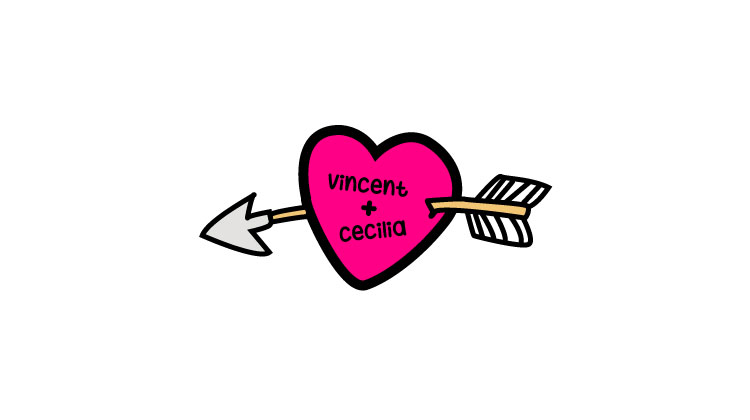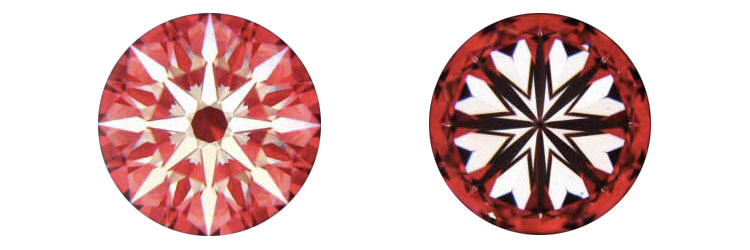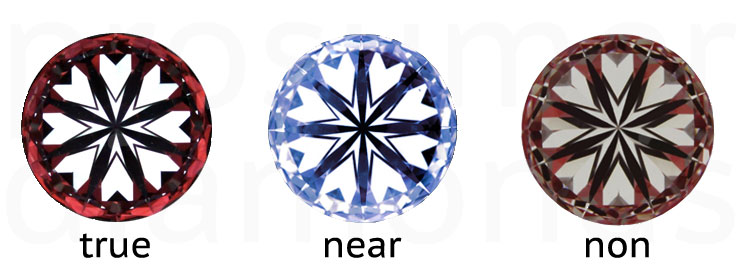
Hearts and arrows (H&A) refer to the 8 arrows that can be seen from the top and the 8 hearts that can be seen from the bottom of a well-cut round brilliant diamond. But while many people will have heard of hearts and arrows before, most people probably don’t know what to look for in a good hearts and arrows diamond. In fact, there’s no official industry standard for hearts and arrows.
Unlike the term ‘blue-white’, which cannot be used to describe a fluorescent diamond in the US, the use of the term hearts and arrows is unregulated so the term has become one of the most misused in the industry with every vendor free to have their own definition of what a hearts and arrows diamond is.
Once I was told by a salesperson that all excellent or ideal-cut graded diamonds exhibit the hearts and arrows effect. This was misleading; at best it was open to interpretation, and if I didn’t know better it would have been easy for me to believe the salesperson because the diamonds I was shown did indeed display some resemblance of hearts and arrows.
It didn’t help that I was told that hearts and arrows was just a marketing gimmick and that there was no visual difference between those diamonds branded as hearts and arrows and the GIA Excellent cut diamonds I was being shown. Of course, I now know that what I was shown was not a hearts and arrows diamond at all.
Mythbusting the H&A
First off, no one actually invented H&A, and it was an accidental discovery by the Japanese. The term “Hearts and Arrows” was trademarked in 1988 by Kinsaku Yamashita who also received a patent for the invention of the hearts and arrows viewer in 1990.
True hearts and arrows is a natural phenomenon that occurs when a 57 facet modern brilliant cut diamond is precision-cut to a narrow range of proportions along with perfect optical symmetry.
The term optical symmetry is to differentiate it from physical symmetry, which is what is graded in the symmetry section the GIA diamond certificate. What you need to know is that excellent physical symmetry doesn’t equal to excellent optical symmetry.
Also, hearts and arrows is not graded by the top labs such as GIA and the AGS. There are some labs out there that do grade hearts and arrows like IGI and HRD, but I have found that those diamonds certified as hearts and arrows by these labs are no guarantee that they are what I consider ‘true’ hearts and arrows diamonds.
So what do I consider a true hearts and arrows diamond?
Assessing H&A, “it’s all in the hearts”
The method of assessing hearts and arrows is an on-going debate, but the method of assessment put forward by Brian Gavin at the first international cut conference in 2004 is currently the most complete definition.
Brian Gavin once told me that when evaluating a diamond, it’s all about the hearts image. One thing I want you to be aware of is that just because a diamond displays hearts and arrows does not make it a super ideal-cut diamond. So please remember that a super ideal-cut diamond is a hearts and arrows diamond with ideal light performance.
Assessing hearts and arrows in a diamond is a visual exercise and the basic criteria are as follows:
- 8 equally symmetric hearts and V’s that are the same size
- There should not be a clef between the hearts
- There should be a slight gap between the V’s and the hearts
- The tops of the hearts should be flattened off
- There should be no yaw, misalignment or distortion of the V’s or hearts
The Hearts and Arrows Viewer
A hearts and arrows viewer is the only proper way to assess hearts and arrows in a diamond. If you have used a hearts and arrows viewer, you will know how difficult it is to tell whether what you’re seeing is perfect hearts. The reason is that any slight shift in your viewing angle will change what you’re seeing. I’ve come to realize that you can only rely on a high quality, perfectly level hearts and arrows image to properly confirm perfect hearts and arrows.
It can be difficult for a store to provide you with a reliable image and this is the primary reason why I recommend that you purchase your diamond from a reputable online vendor who can provide you with a high quality hearts and arrows image that I can help evaluate for you.
Conclusion
There’s no such thing as a truly flawlessly cut diamond just like there is no such thing as truly flawless clarity. If you want to split hairs, there will always be some defect however minor especially when you look at highly magnified hearts images.
Even among super-ideal cut diamonds, one can still differentiate between those that are cut more perfectly than others. What you’ll find is that vendors who sell the best cut diamonds are proud to show off how good their diamonds are by providing high quality and highly magnified hearts images of their diamonds.
If you’re looking for the best craftsmanship, there are not many vendors out there who carry super-ideal hearts and arrows diamonds. These diamonds are usually branded and are sold at a premium because the cost of creating them is higher. I like to think of choosing a super-ideal cut diamond over a near-H&A diamond like choosing a VVS1 clarity over a VS1 clarity diamond.
If you’re looking for a high performing diamond that’s just ‘good enough’. I also respect this and I even recommend that you put your budget into meeting your other minimum criteria before you put it towards cut. If you’re struggling with a budget, I still strongly suggest that you aim for at least a near-H&A and I can help you if you’re finding this difficult to achieve.
If a diamond is slightly out of round, then make sure the opposite sides of its hearts image are symmetrical. Bear in mind that there is a wide range of diamonds that can be considered near-H&A and some defects are preferable to others.
Getting an H&A with the highest level of optical symmetry is confirmation that the numbers stated on the diamond certificate are representative of all 8 sides of your diamond. This is important if you’ve spent a long time trying to find a diamond with perfect proportions!
Now that you know what to look for in terms of optical symmetry and hearts and arrows, you’re one step closer to becoming a diamond prosumer. In the next tutorial, I will tell you how to evaluate ideal light performance in a diamond. Remember that a super ideal-cut diamond requires both ideal light performance and H&A optical symmetry.
If you need someone to check your diamond’s hearts image or to help you find the best near-H&A, then please don’t hesitate to contact me for assistance.


